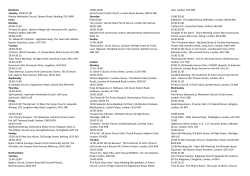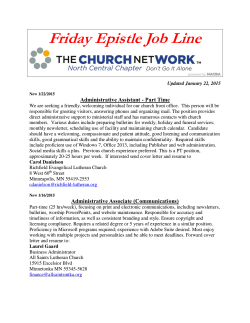
methodist history - gcah - General Commission on Archives and
METHODIST HISTORY April 2015 Volume LIII Number 3 The Ordination of Julia Torres Fernandez EDITORIAL BOARD Morris Davis Drew University Paula Gilbert Duke University A. V. Huff Furman University Cornish Rogers Claremont School of Theology Ian Straker Howard University Douglas Strong Seattle Pacific University Robert J. Williams Retired GCAH General Secretary Anne Streaty Wimberly Interdenominational Theological Center Stephen Yale Pacific School of Religion Charles Yrigoyen, Jr. GCAH General Secretary Emeritus Assistant Editors Michelle Merkel-Brunskill Christopher Rodkey Nancy E. Topolewski Book Review Editor Kevin Newburg Cover: Circa 1960 photograph of Julia Torres Fernandez, the first latina ordained in the Methodist Church. She would later become the first latina with full-clergy rights. Image from the records of the Division of Mission Education, New World Outlook series, GCAH, Madison, New Jersey. METHODIST HISTORY (ISSN 0026-1238) is published quarterly for $25.00 per year to addresses in the U.S. by the General Commission on Archives and History of The United Methodist Church (GCAH), 36 Madison Avenue, Madison, NJ 07940. Printed in the U.S.A. Back issues are available. POSTMASTER: Send address changes to METHODIST HISTORY, P.O. Box 127, Madison, NJ 07940 or email mmerkel@gcah.org. METHODIST HISTORY Alfred T. Day III, Editor Volume LIII April 2015 Number 3 CONTENTS Contributors . . . . . . . . . . . . . . . . . . . . . . . . . . . . . . . . . . . . . . . . . . . . . Editor’s Note . . . . . . . . . . . . . . . . . . . . . . . . . . . . . . . . . . . . . . . . . . . . 130 131 Triangular Integration in a Black Denomination: James Sisson, African Methodism, and the Indian Mission Annual Conference by Christina Dickerson-Cousin . . . . . . . . . . . . . . . . . . . . . . . . . . 133 Vision and Persistence: The Genesis of the First Wesley Foundation by Tami Gallaway . . . . . . . . . . . . . . . . . . . . . . . . . . . . . . . . . . . . . 152 From Rib to Robe: Women’s Ordination in The United Methodist Church by Connor S. Kenaston . . . . . . . . . . . . . . . . . . . . . . . . . . . . . . . . 162 The African and Caribbean Origins of Methodism in the Bahamas by David Bundy . . . . . . . . . . . . . . . . . . . . . . . . . . . . . . . . . . . . . . 173 Book Review . . . . . . . . . . . . . . . . . . . . . . . . . . . . . . . . . . . . . . . . . . . . 184 Minutes of the 2014 Annual Meeting of the Historical Society of The United Methodist Church . . . . . . . . . . . . . . . . . . . . . . . . . . . 186 Eighth Historical Convocation Registration Information . . . . . . . . . . 189 Copyright 2015, General Commission on Archives and History, The United Methodist Church Methodist History is included in Religious and Theological Abstracts, Historical Abstracts and America: History and Life ATLA Religion Database Manuscripts submitted for publication and all other correspondence should be addressed to Editor: METHODIST HISTORY, P.O. Box 127, Madison, NJ 07940. Prospective authors are advised to write for guidleines or visit www.gcah.org. CONTRIBUTORS CHRISTINA DICKERSON-COUSIN teaches at Gateway Community College, New Haven, Connecticut. She received a B.A. in History from Spelman College (2004), graduating Summa Cum Laude and Phi Beta Kappa. She received an M.A (2007) and Ph.D. (2011) from Vanderbilt University, distinguished as a Harold Stirling Graduate Scholar. While matriculating at Vanderbilt, she received fellowships, including the Robert Penn Warren Center for the Humanities Graduate Student Fellowship (2010), the Newberry Library Consortium for American Indian Studies Summer Institute Fellowship (2009), and The John Carter Brown Library Associates Fellowship (2008). She has previously produced articles regarding AME Church history in The AME Church Review and Ethnohistory. CONNOR KENNASTON is a Young Adult Missionary and a Global Mission Fellow with the United Methodist General Board of Global Ministries, co-teaching American Methodist History at Central Methodist University, Fayette, Missouri. He received a B.A. in History from Yale University (2014) graduating Cum Laude. Other academic distinctions include the Andrew D. White Prize for “‘If Men Don’t Fight, the Women Will’: Women and Gender Roles in the West Virginia Mine Wars”; and publication in the Yale Historical. Kennaston’s article was chosen to receive the 2015 Women in United Methodist History Writing Award by the General Commission on Archives and History of The United Methodist Church. TAMI GALLAWAY is a 3rd year M.Div. student at Perkins School of Theology, Southern Methodist University. She is currently completing academic coursework and looking forward to a full-time internship at First UMC Allen, Texas, next year. She will graduate in May of 2016 and looks forward to ordination as a deacon in The United Methodist Church. Her paper has been selected by the General Commission on Archives and History for the 2015 John Harrison Ness Award. This annual award is for the best paper written by an M.Div. student on some aspect of United Methodist history broadly conceived. It was nominated by Ted A. Campbell, Associate Professor of Church History at Perkins School of Theology. DAVID BUNDY is Visiting Professor at Seoul Theological University and Research Professor at New York Theological Seminary. He is a specialist in Methodist, Holiness and Pentecostal History, focusing primarily on issues outside of North America as well as on early Asian and East African Chrisitianities. He is the author of Visions of Apostolic Mission (2009) and numerous scholarly articles. 130 Methodist History, 53:3 (April 2015) EDITOR’S NOTE In Africa recently, traveling for the General Commission on Archives and History, I heard a proverb—not once but twice. It was mentioned first at the installation of Munashe Farusa as new Vice Chancellor of Africa University and again at a meeting of the African Association of United Methodist Theological Institutions (AAUMTI) where I made a presentation about “Preserving Our Story.” The proverb: “Plant trees under whose shade you do not expect to sit.” The folk wisdom therein is about changing the world for the good, leaving things better than you found them in the first place. In current vernacular we say, “Pay it forward”: the beneficiaries of some goodness or grace repaying it ahead instead of backwards. We historians and archivists are sometimes thought of as being backward thinkers. To be sure, we work diligently to lift up things like context and causality but not merely for the sake of indulging in nostalgia. Our work is forward focused, connecting the “back-then” to the “here-andnow” for the sake of making progress. We are tree planters. The roots of the past we reflect on, the trunks and branches, the growth and life cycles we preserve and encourage others to observe are the makings of insights to inspire a better future. The product of our witnessing and interpretations may not be felt for generations. But we dig around, plant thoughts and nurture findings because we want what we do to make a difference, both for the living of these days and the yet-to-be as well. This April issue of Methodist History is a good spring planting. Christina Dickerson’s “Triangular Integration in a Black Denomination” offers a fascinating profile of an extraordinary white minister in the African Methodist Episcopal Church. James Fitz Allan Sisson, a nineteenth-century missionary to Native Americans, black Indians and Southern migrants founded the Indian Mission Annual Conference of the AME in Oklahoma (1897). The article points to the AME Church’s historic outreach to marginalized communities as well as the denomination’s multi-racial aspirations. Tami Gallaway’s “Vision and Persistence: The Genesis of the First Wesley Foundation” is an insightful case study of Park Chapel Methodist Episcopal Church and the Rev. Willard Tobie’s enterprising idea for the student population of the University of Illinois-Urbana being incorporated into the local congregation. The essay is a testimony to Methodist campus ministry as a model for the development of other university religious ministries. 131 132 Methodist History Connor Kenaston’s “From Rib to Robe” is an engaging survey of the ordination of women in the Methodist tradition. It provides the historical context surrounding the Methodist Church’s 1956 decision to grant ordination and full clergy rights to women. It considers recent statistics about clergywomen and assesses the transformational nature of the denomination’s landmark resolve. David Bundy’s “The African and Caribbean Origins of Methodism in the Bahamas” is a case study of Methodism’s beginning on these islands as an African American initiative, not an “official” missionary enterprise from the outside. Grounded in Bahamian scholarship and early Methodist community sources, it argues for a distinctive Methodism whose leaders had little or no direct contact with the British homeland of the movement. There are more trees to plant! Methodist History is always in search of quality, scholarly essays. See the Contents page for submission details. Spread the word! Alfred T. Day III
© Copyright 2025








